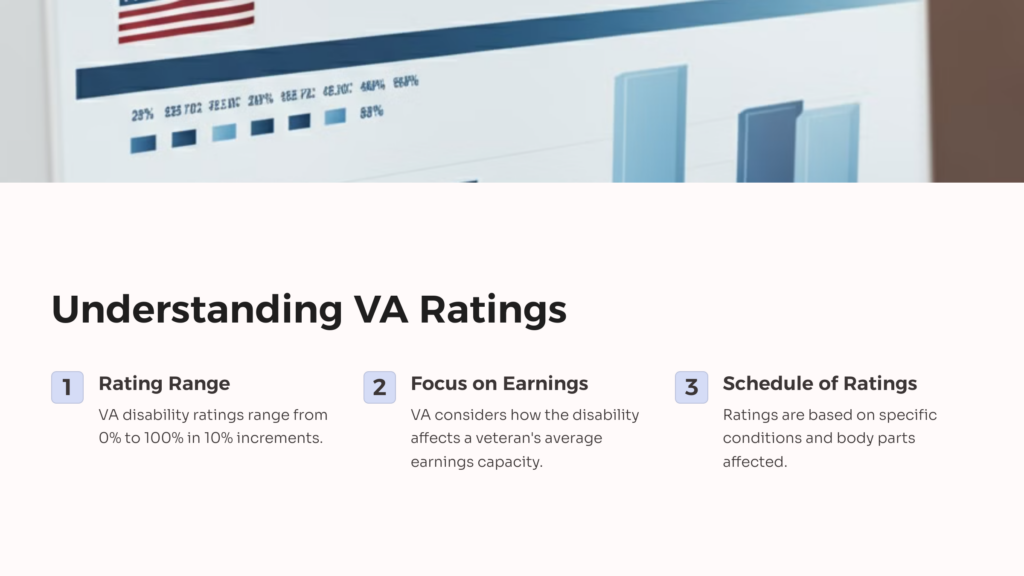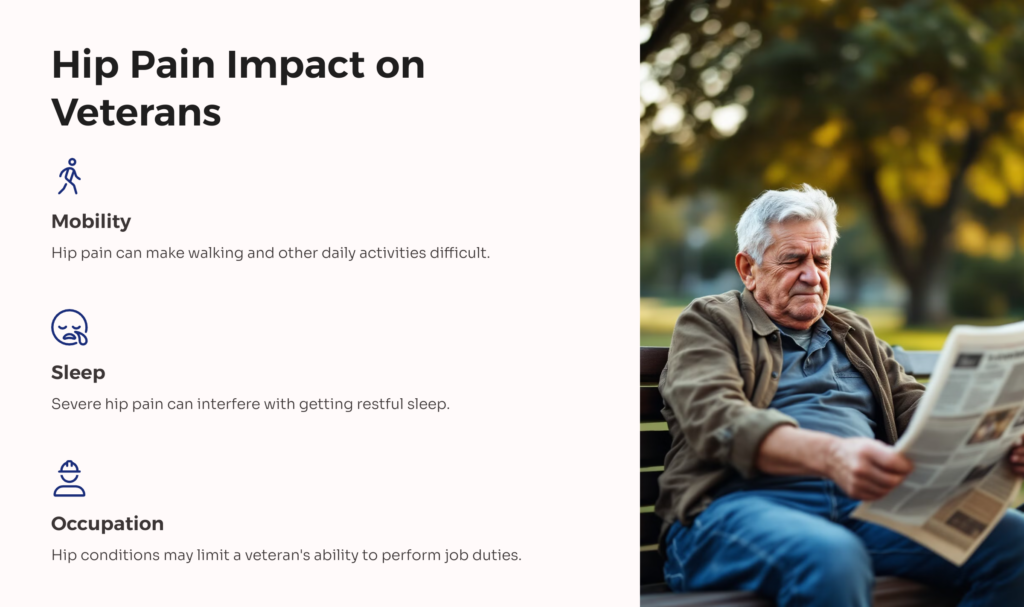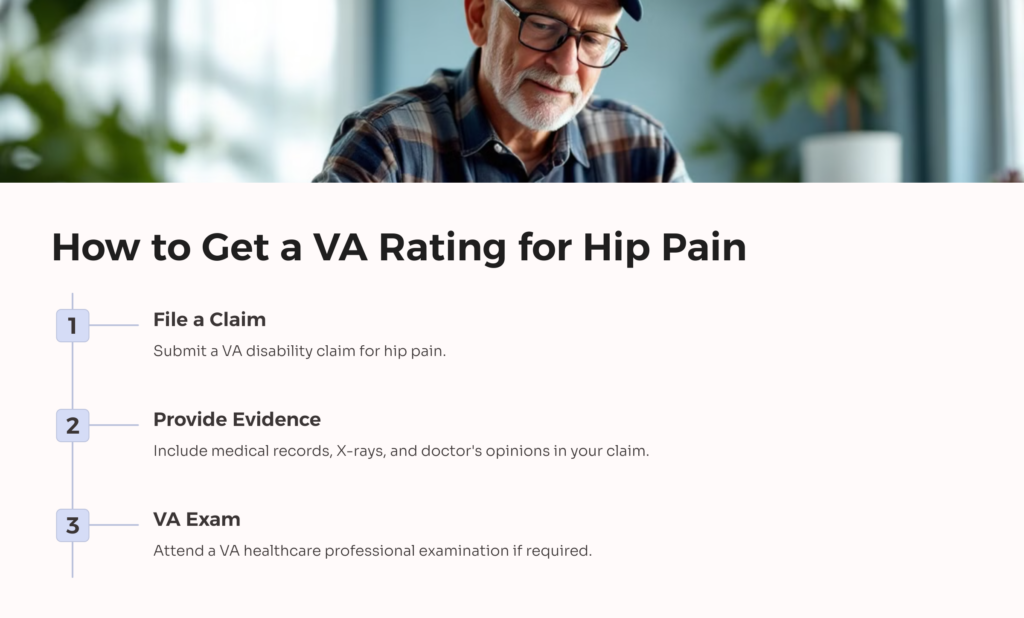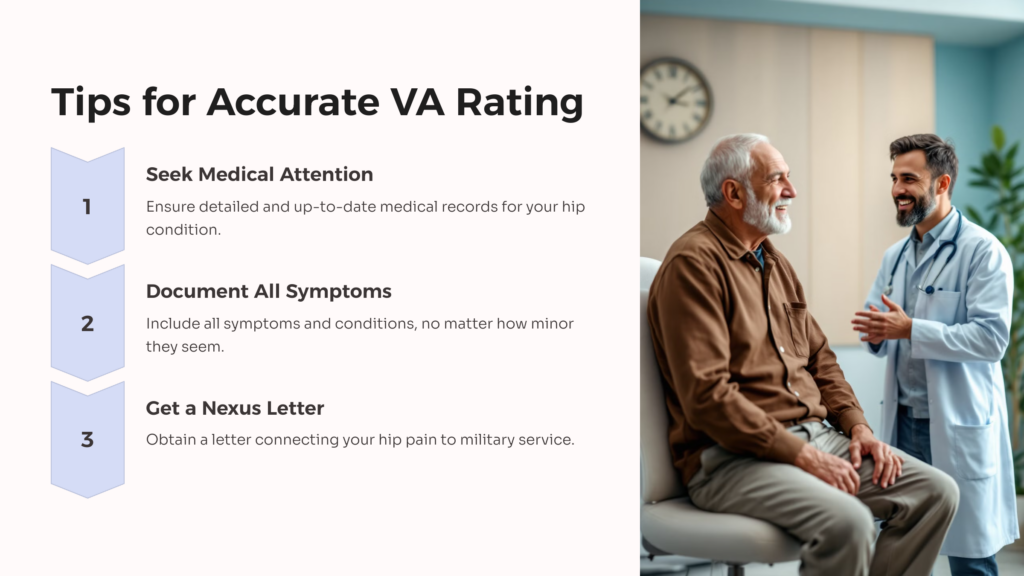Hip pain is a common and disruptive problem that can significantly interfere with an individual’s quality of life. Its impacts can range from mild discomfort to complete debilitation, depending on the severity and the underlying cause. For veterans, the situation can be even more challenging due to their unique experiences in service environments, potentially exacerbating pain and physical conditions. This article addresses the relationship between hip pain and the VA disability rating system – a pivotal factor in determining VA disability compensation for veterans.
The VA rating system is a standardized method mandated by the federal government to assess and categorize the severity of a veteran’s disability. A thorough understanding of this system can help veterans maximize their VA disability benefits and ensure that they receive the support they need for their VA disability claim. The following sections will offer insight into the intricate workings of the VA disability rating system, particularly how it pertains to hip pain.
Understanding VA Ratings

The VA disability rating system uses a diagnostic code to assign disability ratings ranging from 0% to 100%. These increments are usually enlisted in 10% steps, serving as a reflection of the severity of the veteran’s disability. The higher the rating, the more substantial the VA disability benefits.
The concept of ‘disability’ under the VA system might differ from conventional definitions. The VA considers a condition as a disability if it impairs the veteran’s average earnings capacity. It is more concerned with how a service member’s average earnings are affected by the disability rather than the medical condition itself. The central focus is on how the disability influences occupational functioning. A VA disability claim is for health benefits and for VA disability benefit payments to help assist the veteran.
The VA rating criteria function on a schedule of ratings that define how the degree of a veteran’s disability translates into a percentage. These ratings vary based on every part of the body and specific conditions.
Hip Pain and its Impact on Veterans

Hip pain can have a profound impact on a veteran’s daily life, making simple activities like walking, sitting, or even sleeping difficult. The intensity of the hip joint pain can likely escalate and extend into knee pain under severe strain or physical activity which many veterans undergo during their service.
Veteran populations often suffer from various causes of hip pain, including osteoarthritis, hip fractures, bursitis, tendinitis, various muscular strains, and even physical trauma. Each of these conditions can develop or worsen due to physical exertion, demanding environments, or injuries sustained during active duty. This is where VA benefits can come in to help veterans.
VA Rating for Hip Pain
VA rating for hip pain, as joint pain could be either under the Ankylosis disability category, which considers reduced mobility, or the Arthritis category. In the first, ratings range from 10% to 50%, and in the latter, they can be assigned ratings of 10%, 20%, or 30%.
The disability rating depends on various factors, including the degree of joint degeneration or destruction, the frequency and severity of painful flare-ups, and the impact of the hip condition on one’s ability to perform occupational tasks. It’s crucial to note that any veteran receiving VA disability compensation is evaluated based on their service connected disability.
Understanding Hip Conditions Recognized by VA
The VA recognizes a range of hip conditions that can qualify for a veterans disability benefit, including but not limited to hip dislocation, arthritis of the hip, hip replacement, hip muscle injury, hip dysplasia, and ankylosis of the hip. Each of these conditions can significantly affect the hip’s functionality and mobility, directly influencing a veteran’s ability to perform occupational tasks or enjoy a quality life.
How to Get a VA Rating for Hip Pain

The VA rates disabilities in percentages, a 0% rating being a recognized disability but the lowest rating, and 100% disability being considered a full disability. Rating disabilities differs by case and each veteran will submit their claim for VA compensation and be evaluated.
To get a VA rating for hip pain, a veteran would need to file a VA disability claim. A mandatory criterion is the veteran must be discharged from their military duties under honorable circumstances.
The documentation process involves providing substantial medical evidence, including X-rays, MRI reports, doctor’s opinion letters, and more to show it’s a service connected disability. An exam with a VA healthcare professional might also be required.
Tips for Getting an Accurate VA Rating for Hip Pain

To improve the chances of getting an accurate VA rating, first and foremost, seek professional medical attention to ensure that your medical records are detailed and up-to-date. Ensure you include all medical diagnoses and reports relevant to the hip pain. Do not omit any symptoms or conditions, however small they may seem.
Secondly, it’s necessary to get a nexus letter from a healthcare provider that establishes a direct connection between your hip pain and military service, as the proof of service link is vital for a successful claim.
Appeals Process for VA Ratings
Sometimes, a veteran may disagree with what the VA rates their hip pain. If this is the case, there’s an appeals process they can follow. To initiate this process, the veteran would need to file a Notice of Disagreement (NOD) and can also request a hearing.
Hip pain can significantly disrupt a veteran’s life, affecting everyday activities and overall quality of life. The VA aims to mitigate this impact through their disability compensation process. Understanding the ins and outs of the VA rating system, hip conditions, and how to effectively navigate the process can prove pivotal for veterans experiencing a hip injury.
The importance of securing an accurate VA rating for hip pain cannot be overstated. Adequate compensation ensures that veterans can focus on managing their pain and other aspects of their lives without worrying about financial strain.
We invite veterans everywhere to check us out at AllVeteran.com. Take our quiz for a free medical evidence screening, today!
 AllVeteran.com Advisors
AllVeteran.com Advisors
With expertise spanning local, state, and federal benefit programs, our team is dedicated to guiding individuals towards the perfect program tailored to their unique circumstances.


















